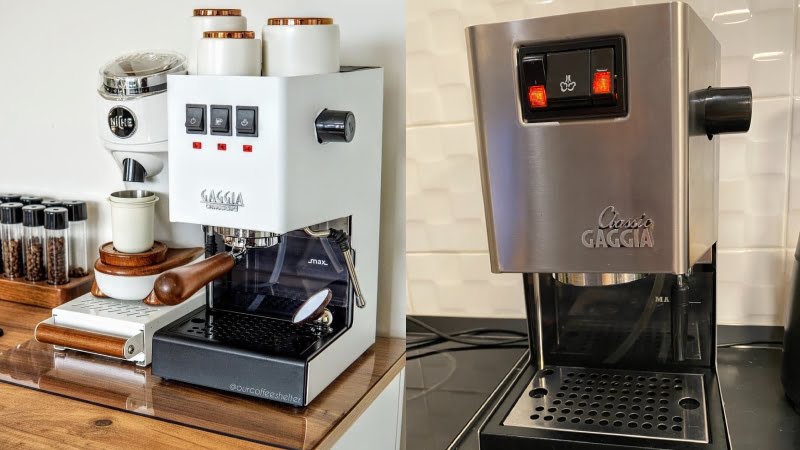In this showdown of Gaggia Classic vs Gaggia Classic Pro, these two machines proudly wear the badge of entry-level semi-automatics, and one cannot deny their striking similarities. However, casting an insightful eye over the contest reveals the Gaggia Classic Pro’s ascent to triumph, empowered by its unique differences and many compelling updates. It’s noted that I am referring to the illustrious 2015 version of the Gaggia Classic.
Building upon the foundation of the Gaggia Classic, the Gaggia Classic Pro demonstrates a profound understanding of its users’ desires by resurrecting some cherished features absent in the Gaggia Classic 2015. Reintroducing the 3-way solenoid valve, ensuring a drier coffee puck, and using an aluminum boiler for quicker heating are standout improvements that enhance the machine’s performance. Moreover, including Professional steam wands elevates the Pro model to an even higher level of excellence.
The Gaggia Classic 2015 is one of the most controversial versions in the lineup. Removing the 3-way solenoid valve and featuring push buttons that tend to be sticky have raised eyebrows. Despite these changes, I cannot overlook its core competence. As an affordable semi-automatic machine, it excels in brewing delicious espresso. Moreover, it impresses with features typically found in professional coffee machines, such as the 58mm portafilter and stainless steel body.
Gaggia Classic vs Gaggia Classic Pro: Comparison Chart




Last update on 2025-04-14 / Affiliate links / Images from Amazon Product Advertising API
Gaggia Classic vs Gaggia Classic Pro: Differences
Gaggia Classic Pro emerged victorious, outshining the Gaggia Classic with an impressive score of 3-0. Explore my detailed comparison to find the perfect fit for your needs!
Coffee Flavor, Brewing, And Milk System
Winner: Gaggia Classic Pro
Coffee Flavor
Gaggia Classic Pro and Gaggia Classic are semi-automatic, as both demand active involvement from the user during the brewing process. I love these machines because they brew top-notch café-style espresso, and I can control stuff like grind size, brew time, dose size, etc.
The semi-automatic machine requires a standalone grinder to grind the coffee beans, dose them precisely, and give it a manual tamp. (I often use the Breville Smart Grinder Pro grinder), these machines boast a powerful 15-bar pump pressure system, ensuring no drop of espresso goodness is left behind. Now, the burning question is – do they produce different coffee flavors?
As I cast my eyes upon their espresso cups, the distinction in color between the two brews is unmistakable. The Gaggia Classic Pro’s espresso presents a deep, darker shade, whereas the Gaggia Classic’s espresso leans towards a lighter shade. However, when it comes to taste, both espressos surprisingly exhibit an uncanny resemblance. I can’t quite discern any noticeable difference in their flavors.
Heating System
While some may yearn for the convenience of dual boilers for simultaneous steam and hot water heating, the Gaggia Classic vs Gaggia Classic Pro indeed features a single boiler. However, from my perspective, this aspect didn’t disappoint, as I am well aware that as entry-level machines, incorporating a single boiler helps to optimize costs and minimize the machine’s footprint.
With a single boiler system, the Gaggia Classic and Gaggia Classic Pro cannot multitask, causing a brief pause between brewing espresso and frothing milk. While this inconvenience is generally tolerable for home use, it might pose a challenge if you’re in a rush or preparing multiple cups of joe.
Furthermore, these machines truthfully deliver hot cups every time, which means the single boiler feature is far from being a drawback. However, the coffee brewed by the Gaggia Classic will be slightly cooler than that by the Gaggia Classic Pro. I would estimate around a couple of degrees cooler.
These machines showcase remarkably contrasting boiler performances despite sharing the same single boiler design. The key lies in their chosen boiler materials, contributing to varying heat-up times.
The Gaggia Classic boasts a stainless steel boiler, ensuring protection against corrosion; however, this choice does come with a trade-off – a slower heat-up time, taking approximately 5 minutes or more.
Meanwhile, the Gaggia Classic Pro features an aluminum boiler, offering the distinct advantage of achieving initial heat-up in just around 1 minute.
Although the exact figures may not be precise, one undeniable fact prevails – the Classic Pro’s aluminum boiler outperforms the 2015 Classic’s stainless steel boiler regarding quick heating.
Milk System
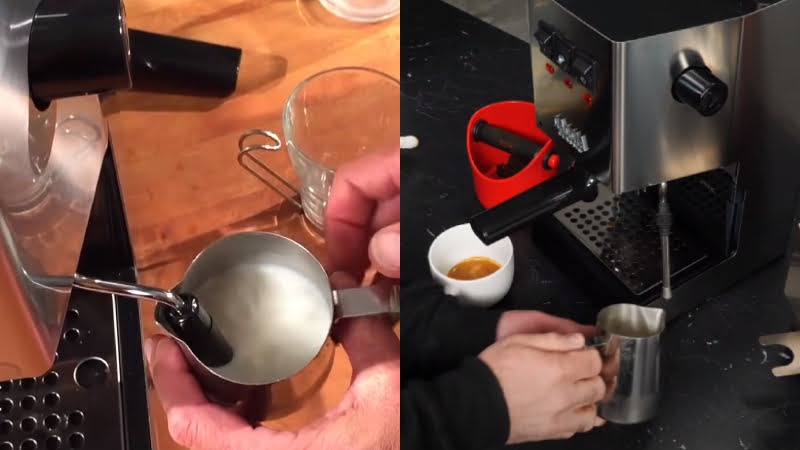
When it comes to frothing up that velvety milk for your lattes and cappuccinos, the two machines definitely bring some differences to the table.
The Gaggia Classic uses a Panarello-style steam wand, which is cool for frothing milk for lattes, but when it comes to the dry foam I crave in a cappuccino, it falls a bit short. But I usually work around this by swapping it out for a Rancilio Silvia wand. It’s a simple and affordable upgrade.
I used to wonder why Gaggia didn’t offer a version with a proper steam wand, considering so many of us mod our Gaggia Classic machines. They’ve finally answered our prayers with the Gaggia Classic Pro. It has a pro-level milk frother – just like the ones you see at fancy coffee bars. It is a metal tube with a bulb on the end sporting two tiny holes. But it takes some know-how to master this wand. So, if you’re new to this game, getting the perfect froth might be a bit of a challenge.
It only requires a bit of practice so that you can steam and froth milk for cappuccinos and lattes that’ll make you feel like a barista extraordinaire! Its milk foam is creamy and smooth, with no big bubbles.
Design & Usability
The Winner: Gaggia Classic Pro
Pump Mounting
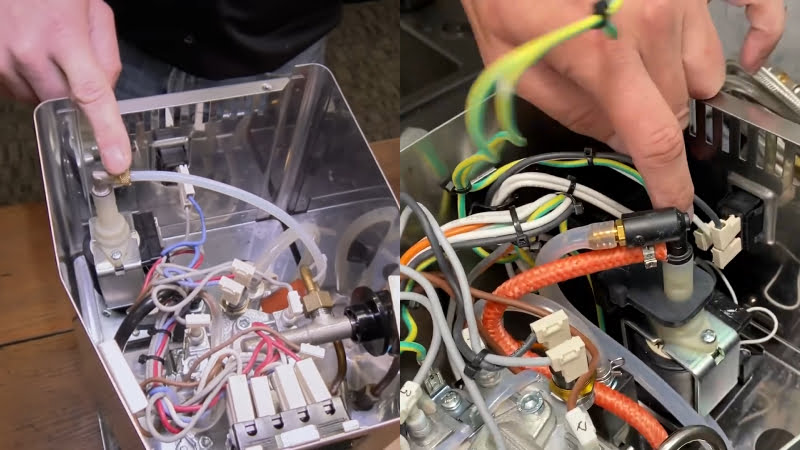
The Gaggia Classic Pro ingeniously incorporates extra rubber components in its pump mouth, resulting in a slightly quieter operation. Don’t assume it’s as silent as a gentle whisper; instead, the noise is somewhat mitigated, yet I can still perceive the rhythmic workings of the pump. This is understandable when dealing with vibrating pumps encased within a sturdy metal frame like this.
Water Tank
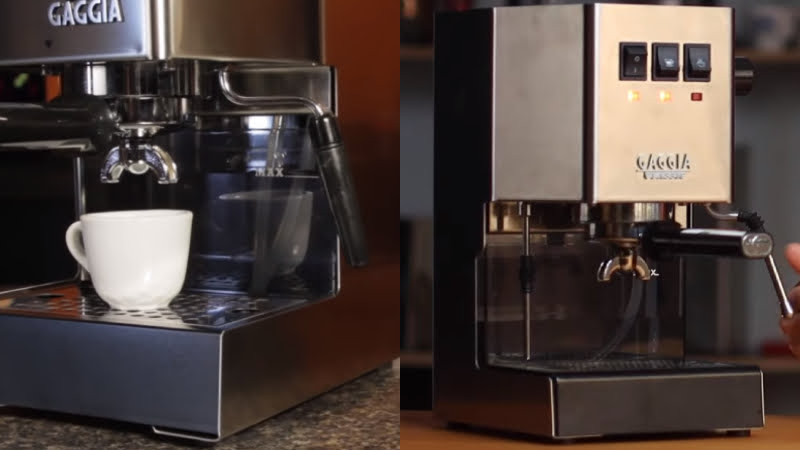
The water tanks in both machines have a similar capacity, holding approximately 2.1 liters of water. Some may find it insufficient for a household of two avid coffee drinkers and constantly refilling it becomes necessary. However, the process is relatively easy – simply remove the drip tray and fill the water directly from the tank or you can just take the lid off the top and fill the water easily from there.
While using the Gaggia Classic, one prominent weakness that I and numerous other users grumble about is the obscured water level within the tank. This inconvenience arises due to its placement on the inside and the usage of tinted plastic.
As I engage with the Gaggia Classic Pro, I notice the thoughtful incorporation of cuts on two sides, seemingly an effort to address the above drawback found in its predecessors that users consistently complained about the water level is hard to check. And indeed, it does. However, this improvement falls short as the root of the problem lies within the water tank itself. It is deeply nestled inside the machine and crafted with non-transparent plastic.
Furthermore, the drip tray’s positioning becomes problematic as it covers a significant part of the water tank, leaving the contents beneath this level out of sight. Notably, this hidden area boasts an ample volume of 22 oz or 700 ml of water, a substantial amount for an espresso machine.
User Interface
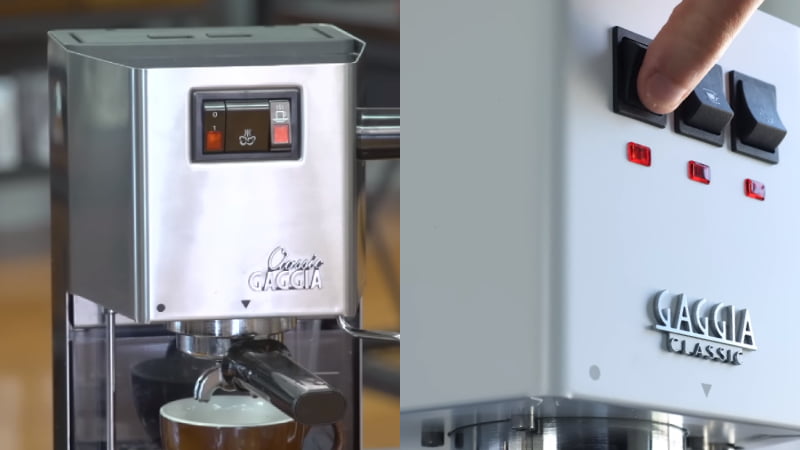
Another notable distinction between the Gaggia Classic and the Gaggia Classic Pro lies in their user interfaces.
In the Classic 2015 version, it introduced push buttons instead of the rocker switches. However, the buttons tend to stick. It’s really frustrating!
Gaggia attentively took note of users’ complaints regarding the sticking buttons on the Gaggia Classic, and in response, they introduced a thoughtful improvement in the Gaggia Classic Pro. The Classic Pro now features three convenient rocker buttons, which have effectively resolved the issue of buttons getting stuck.
Moreover, the Classic Pro’s user interface is further enhanced by including three indicator lights corresponding to the on/off, espresso, and steam functions. These indicator lights make it incredibly easy for me to discern when the machine has reached the optimal temperature for each specific process.
Nonetheless, I have encountered instances where the rocker buttons don’t respond immediately to the first touch. I might need to press and hold for a few seconds before it stays in place.
Utilities
The Winner: Gaggia Classic Pro
Cup Warmer
I must highlight a delightful, hidden gem in these machines – the top of these machines is made of stainless steel, and it naturally becomes a cup warmer. This thoughtful addition allows me to warm my cups while waiting for the machine to reach its ideal temperature. With this considerate addition, I bid farewell to worries about pouring my drink into a cold cup, a common issue leading to drinks that are perceived as less hot than desired.
3-way Solenoid Valve
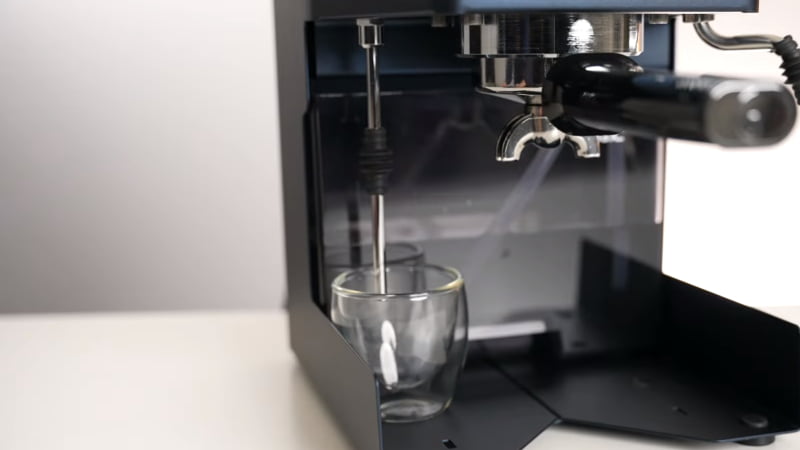
One notable disparity is the presence of a 3-way solenoid valve in the Gaggia Classic Pro, which is absent in the Gaggia Classic. Strictly speaking, Gaggia Classic removed this feature in the 2015 model while it was still equipped in the pre-2009 version. Personally, I find this decision puzzling, as it seems like a bit of a setback.
The 3-way solenoid valve is a clever mechanism that releases pressure from the group head after an extraction. This means I can remove the portafilter immediately without any mess, as the used coffee puck remains dry and prevents splattering of water and coffee grounds. While the 3-way solenoid valve may not directly impact the espresso quality, it greatly enhances the overall experience, making it effortless and cleaner.
Its cleaning benefits become apparent when Gaggia Classic doesn’t have this valve. I must wait a few minutes for the pressure to dissipate naturally instead of immediately removing the portafilter. I once removed the Portafilter prematurely, and it led to an unpleasant mess of hot coffee grounds splattering over my machine and the countertop.
Gaggia Classic vs Gaggia Classic Pro: Similarity
Appearance
I was instantly impressed by the Classic Pro and Classic’s robust construction. They have a stainless steel housing, exuding a sense of solidity and sturdiness. Some may even find it to have an industrial charm, depending on personal taste.
When I lifted the machines out of the box, their weight surprised me. Weighing around 20 pounds, these espresso machines are substantial, making them a fixture I just want to leave in place on my counter.
Cup Clearance
Both the Gaggia Classic Pro and Gaggia Classic are designed with small, traditional espresso cups in mind. It can’t accommodate a large American-style mug or tall latte macchiato glasses.
If you want to use a full-sized cup or scale with these machines, I recommend you actually fully remove the drip tray. Note that you have to place a small cup under the solenoid outlet so that there is no mess. I know it is not an elegant solution, but it is really effective.
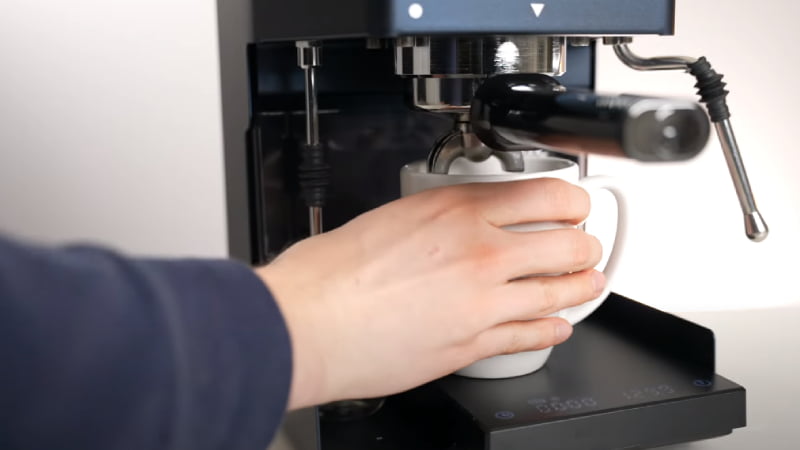
Portafilter
The 58mm portafilter on both the Gaggia Classic and Gaggia Classic Pro allows me to pull single or double espresso shots. Throughout my extensive testing of numerous espresso machines, this portafilter’s excellence remains unmatched in my memory. Its remarkable balance and substantial weight resemble those of commercial-grade machines.
Tamper
As is common with budget-friendly machines, both of these espresso machines come equipped with a plastic tamper. It is just about better than nothing, but the tamper feels somewhat flimsy. Once you become proficient with using this machine, I strongly recommend investing in a stainless steel tamper for more consistent and refined results.
Quick Rundown of Gaggia Classic Pro
- Solid Steel Housing, Made in Italy
- 9 Bar Espresso Extractions
- Stainless Steel 58mm Commercial Portafilter
- Commercial Three Way Solenoid Valve
- Commercial Steam Wand
Last update on 2025-04-14 / Affiliate links / Images from Amazon Product Advertising API
Quick Rundown of Gaggia Classic
- Rugged brushed stainless steel housing
- Commercial three-way solenoid valve
- Commercial-style 58mm chrome-plated brass portafilter and Brew Group
- Easy-to-use Turbo-Frother steam wand attachment
- Easy-to-use Turbo-Frother steam wand attachment
Last update on 2025-04-14 / Affiliate links / Images from Amazon Product Advertising API
Product Videos
Related Articles to Gaggia Classic Pro
- Gaggia Brera vs Classic Pro: Which Model Should You Choose? Are Fully-automatics better?
- Gaggia Carezza Deluxe vs Classic Pro: Comparison Of The Two Espresso Machines For Entry-level
- Gaggia Classic Pro vs Quickmill 820: 2 Machines With Secure Mounting – Which One Brews Better Espresso?
- Flair Pro 2 vs Gaggia Classic Pro: A Worthwhile Debate Of Conventional Vs Unique Machines
- Flair 58 Vs Gaggia Classic Pro: Detailed Comparing to Find The Better One
- Rancilio Silvia M Vs Gaggia Classic Pro: A Detailed Comparison
- Lelit Anna 2 Vs Gaggia Classic Pro: Which One Do I Prefer More?
- Lelit Anna Vs Gaggia Classic Pro: Which Semi-automatic Machine Is Better?
- Breville Infuser vs Gaggia Classic Pro: Honest Comparison Of 2 Budget Machines For Beginners
- Breville Duo Temp Pro vs Gaggia Classic Pro: 5 Differences To Find Out Why You Should Invest In the Duo Temp Pro
- Breville Bambino Plus Vs Gaggia Classic Pro: Which Is Suitable For Your Taste?
- Breville Barista Express Vs Gaggia Classic Pro: Which Is A More Suitable Purchase?
Related Articles to Gaggia Classic
- Gaggia Classic vs Rancilio Silvia: Which Is The Better Entry-level Machine For Home Use?
- Gaggia Carezza Deluxe Vs Classic: 2 Best Entry-level Options For Home Espresso
- Gaggia Brera vs Classic: Should We Choose Semi or Fully Automatic Espresso Machines?
- Breville Bambino Vs Gaggia Classic: A Battle Between Two Beginner-Friendly Models
- Breville Infuser vs Gaggia Classic: Which One Gives You a Better Home Espresso Experience?
- Breville Duo Temp Pro Vs Gaggia Classic: Which Is The Greater Choice Between These 2 Espresso Machines?
References:
- Gaggia Classic Pro: https://www.gaggia-na.com/products/gaggia-classic-pro
- Gaggia Classic: https://www.gaggia.com/manual-machines/new-classic/

I’m Floyd J. Alcock, an experienced barista with a deep love for coffee. I curate personalized coffee experiences, guiding customers through diverse flavor profiles and suggesting ideal brewing methods. My extensive knowledge of espresso machines enables me to recommend the best equipment to match specific needs and budgets. Sharing my expertise and passion with coffee enthusiasts brings immense satisfaction. I look forward to continuing my journey of coffee discovery with every customer I serve, fostering connections over a shared love for this magical beverage.
